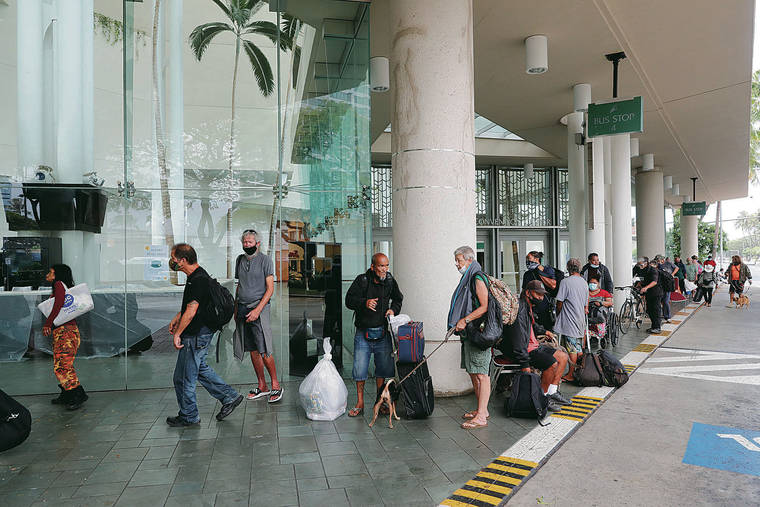Oahu not overwhelmed by Hurricane Douglas shelter turnout

JAMM AQUINO / JAQUINO@STARADVERTISER.COM
Evacuees wait to be screened prior to entry into the Hawai’i Convention Center — an American Red Cross shelter set up in advance of Hurricane Douglas — on Sunday.
More than 350 people sought refuge Sunday at “last resort” emergency shelters on Oahu out of concern over Hurricane Douglas, which had a dangerous brush with Hawaii’s most populous island.
The vast majority of at least 300 people hunkered down at the Hawai‘i Convention Center, which was one of 13 shelters on the island and offered safety to as many as 1,600 people even with social distancing measures in effect.
A significant number of occupants at the facility were there because they had no traditional home of their own, including residents of the city’s Hale Mauliola temporary housing complex at Sand Island made from shipping containers to serve the homeless.
“We’re just going to get by this day,” said Chevy Hoopii, who relayed that Hale Mauliola was evacuated by the city because of its coastal location. “I’m not scared.”
>> PHOTOS: Hurricane shelter opens at Hawai’i Convention Center Opens in a new tab
Germaine B. Justo, another Hale Mauliola resident, arrived at the convention center with her dog Sammie at about 10:30 a.m. She said she was excited to see the storm.
Don't miss out on what's happening!
Stay in touch with breaking news, as it happens, conveniently in your email inbox. It's FREE!
“This is my first hurricane,” Justo said while mingling outside the facility with others at about 1 p.m. “I wish I could stand out here and watch.”
Thirteen shelters opened at 9 a.m. across Oahu.
Occupancy at other shelters was mostly light. The next-biggest turnout as of about noon was 44 at Nanakuli High and Intermediate, according to Honolulu Mayor Kirk Caldwell.
Other shelters had fewer than 10 occupants, including only one person or family at some.
By comparison, in 2018 during Hurricane Lane, about 15 shelters accommodated roughly 1,000 people on Oahu.
On the neighbor islands, five shelters opened on Maui, one on Molokai and one on Lanai. Kauai County planned to open at least three shelters.
Honolulu city officials and the American Red Cross were operating the shelters on Oahu, which was a departure from the past when the Red Cross typically handled such operations.
Because of the coronavirus pandemic, the Red Cross encountered a 70% decline in volunteers, so the city Department of Parks and Recreation helped with staffing.
“We’ve really done a good job having all hands on deck,” said Nathan Serota, a spokesman for the agency.
The city and Red Cross officials said shelters represented a last resort for safety if people didn’t feel safe in their own homes or other places.
“Shelter in-place at home, with family, or with a friend or neighbor if it is safe,” the Red Cross advised.
Still, not everyone heeded the advice as Douglas crept close to Oahu. At about 2:30 p.m. some homeless individuals remained at tents along Waimanalo Beach Park.
The city coordinated with homeless outreach providers to provide transportation to shelters using city buses. That service ran until 12:30 p.m. so that buses could be off the road by 1 p.m.
All shelters were accepting pets, according to the city, which said they had to be in a carrier or cage.
Shelters also required occupants to wear masks at all times when not eating, sleeping or drinking during their stay, though exceptions were to be made for those with medical conditions.
The city said masks were available at shelters, but other supplies including food, water, bedding and hand sanitizer were the responsibility of those staying at the facilities.
To also guard against the spread of COVID-19, temperature checks were being administered by National Guard personnel stationed at the shelters.
Shelters also implemented social distancing and had separate rooms available as quarantine areas for anyone with the virus or symptoms.




